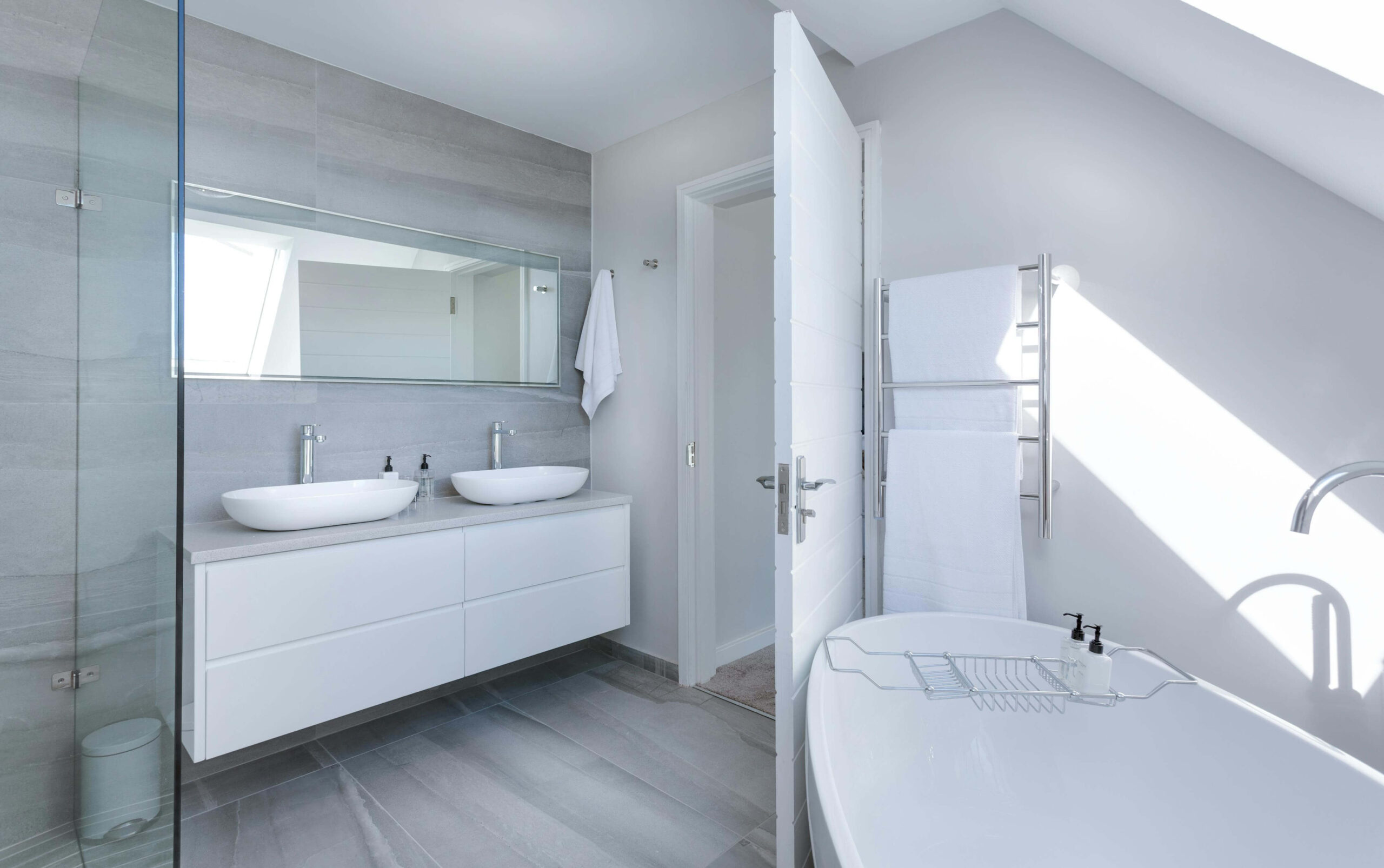
Are you dreaming of a luxurious or sleek and modern bathroom? Your bathroom is more than just a functional space—it’s a sanctuary where you start and end each day. But it might be time for a renovation if your current bathroom feels outdated, cramped, or simply uninspiring.
A well-executed bathroom renovation can dramatically improve your home’s functionality, efficiency, and value. It can also enhance your daily routine and improve your quality of life.
In this comprehensive guide, we will walk you through each phase of the bathroom renovation process, equipping you with the necessary knowledge to ensure you understand what to expect and what questions to ask to secure the results you envision.
Before starting your bathroom renovation project, you must carefully understand your goals and plan. That means preparing a solid plan that will help you reach your goals.
These are the essential steps to help you assess your needs, set your budget, and decide on the scope of your bathroom renovation:
Before starting your bathroom renovation, assess your needs, wants, and preferences. Consider the function of your bathroom and how you use it.
Do you need more storage space, a larger shower, or a bathtub? What needs to be fixed in your current bathroom? What features do you want to add?
Think about your preferred style and aesthetics and what will work best for your space. You can gather inspiration from various sources such as magazines, Pinterest, Instagram, or Houzz.
Setting a budget will help ensure your bathroom renovation stays on track. On average, bathroom renovations cost between $10,000 – $30,000, so you want to determine your spending limit early. How much can you afford to spend, and what are your priorities? Consider the cost of materials, labor, and any additional expenses such as permits or design fees. Allocating your budget wisely is important to achieve the best results.
Deciding on the scope of the renovation is another critical step in the planning process.
Determine what changes you want to make and what aspects of your bathroom you want to keep.
Consider whether you want to update the fixtures, replace the flooring, or reconfigure the layout.
Balance your goals and budget to create a realistic plan.
Finding inspiration and defining your style is an exciting part of planning. You can gather inspiration from various sources such as magazines, Pinterest, Instagram, or Houzz.
Consider the style and aesthetics you prefer, whether it’s modern, traditional, or transitional. Defining your style direction will help you make informed decisions about your renovation and achieve the desired look.
Selecting the right contractor is pivotal to the success of your bathroom renovation. An adept contractor not only helps you realize your vision within your budget and timeline but also ensures a smooth, hassle-free renovation experience. Conversely, the wrong choice could lead to endless headaches, unfinished work, and soaring costs.

It’s important to hire a self-sufficient contractor who can handle all aspects of the project. This includes everything from obtaining necessary permits to ordering materials and coordinating with subcontractors.
A self-sufficient contractor will ensure that your project runs smoothly and is completed on time and within budget.
When hiring a contractor, look for someone who is responsive, responsible, and honest. A responsive contractor will keep you informed throughout the project and promptly address any concerns or issues that arise.
A responsible contractor will take ownership of the project and ensure everything is done correctly. An honest contractor will be transparent about costs and timelines and will not try to upsell you on unnecessary services or products.
Certain aspects of your bathroom renovation project require the expertise of specialists, such as an electrician or plumber.
Here are some tasks that can be DIY projects or require professional expertise:
Hiring experts as needed will ensure the project is completed safely and correctly. Your contractor should have a network of trusted specialists they can call upon when needed.
If you’re working with a contractor to renovate your bathroom, clearly communicate your vision. Share your budget, needs, and style preferences with your contractor and ask for their input and ideas. A good contractor will work with you to help you achieve your goals within your budget.
When designing your bathroom, here are a few common design elements and trends to consider:
The materials you choose will impact your bathroom renovation’s durability, aesthetics, and cost. Here are some tips to help you make the right choices for your bathroom renovation.
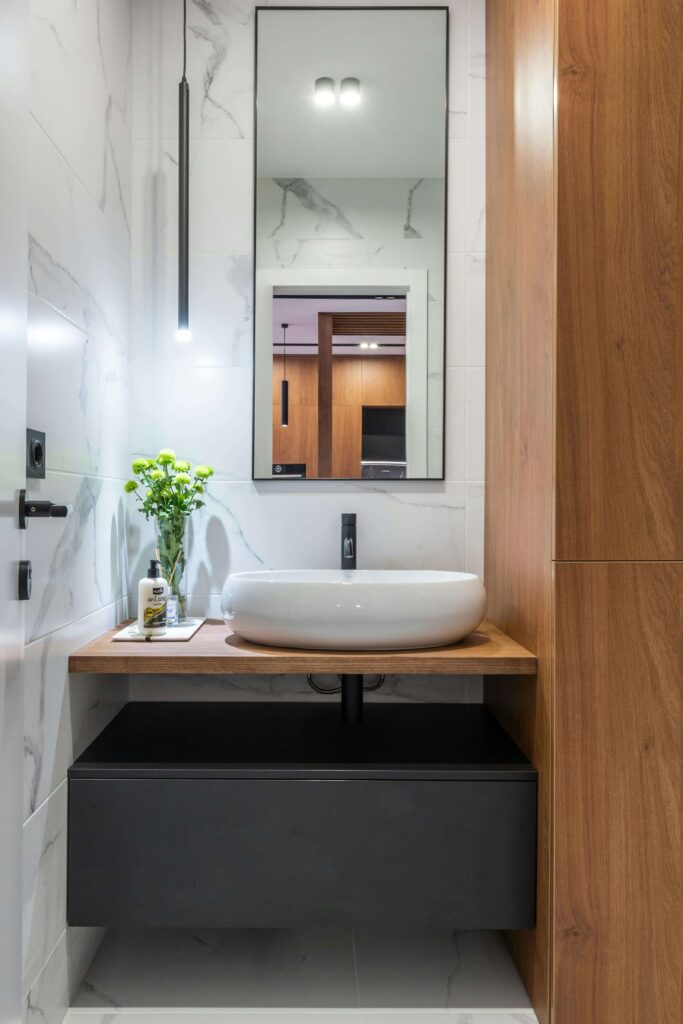
One of the most important decisions you’ll make is choosing suitable materials for your renovation. Consider the overall design and layout of your bathroom, as well as the space you have available.
For example, if you have a small bathroom, choose lighter colors and smaller tiles to make the space appear larger. Various material options are available, including natural stone, porcelain, and ceramic tiles.
Natural stone is a popular choice for bathroom flooring and countertops because of its durability and aesthetically pleasing appearance. Porcelain and ceramic tiles are also popular because they are durable and come in various colors and styles.
When choosing materials and fixtures for your bathroom renovation, balance cost, durability, and aesthetics. While natural stone may be more expensive than porcelain or ceramic tiles, it’s also more durable and may last longer.
In addition, choosing fixtures that are both aesthetically pleasing and durable can help you get the most value for your money.
If you’re looking for eco-friendly and sustainable options for your bathroom renovation, there are various options to choose from. For example, you can choose low-flow toilets and showerheads to conserve water or opt for recycled glass countertops and tiles.
Other eco-friendly options to consider include:
Choosing the right materials and fixtures for your bathroom renovation is an important decision that requires careful consideration.
Bathroom renovations can be a transformative experience for homeowners but can also be complex and time-consuming projects.
The timeline for a bathroom renovation can vary depending on the scope of the project and the materials being used. However, a typical renovation can take anywhere from four to eight weeks to complete.
The timeline can be broken down as follows:
Note that unexpected delays can occur during any stage of the renovation process, so it’s best to build some flexibility into your timeline.
Bathroom renovations can be challenging projects, and you might encounter some challenges during the renovation process.
Be prepared for these potential hurdles:
Being aware of these common challenges and taking steps to address them will help ensure a successful bathroom renovation project.
Now that your bathroom renovation is complete, it’s time to add the finishing touches and finally protect your investment with proper maintenance.
Personal touches such as artwork, decorative elements, and plants can add warmth and personality to your space.
For example, additional lighting can brighten up the space or create a relaxing ambiance. Accessories such as soap dispensers, toothbrush holders, and towel racks can also complete the look.
To ensure that your newly renovated bathroom stays in top condition, follow proper maintenance and care guidelines.
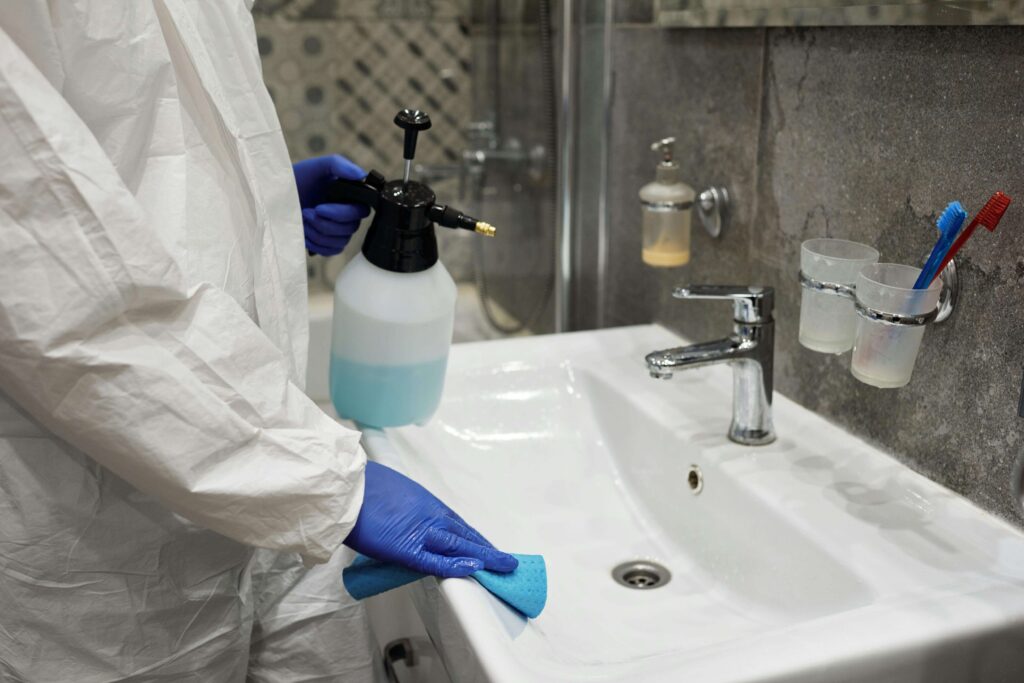
While your newly renovated bathroom may be perfect for now, it’s important to consider when it may be time for future updates or upgrades.
As your needs and preferences change over time, you may want to consider updating your fixtures, surfaces, or layout to suit your needs better.
Keep an eye out for signs of wear and tear, such as chipped tiles or worn finishes, which may indicate that it’s time for an update.
A bathroom renovation is a significant undertaking, but with careful planning and execution, it can dramatically improve your daily life and your home’s value. Whether you’re looking for a simple refresh or a complete overhaul, this guide provides a solid foundation for your project.
At Next Level Construction, we specialize in bathroom renovations in NYC. We’re committed to turning your bathroom renovation dreams into reality. Whether you’re a homeowner in Manhattan, Queens, Brooklyn, the Bronx, Staten Island, or Nassau County, we’re here to help!
Ready to get started on your bathroom renovation project? Contact Next Level Construction today for a consultation.
Let’s work together to create the bathroom you’ve always wanted—on time, on budget, and beyond your expectations.
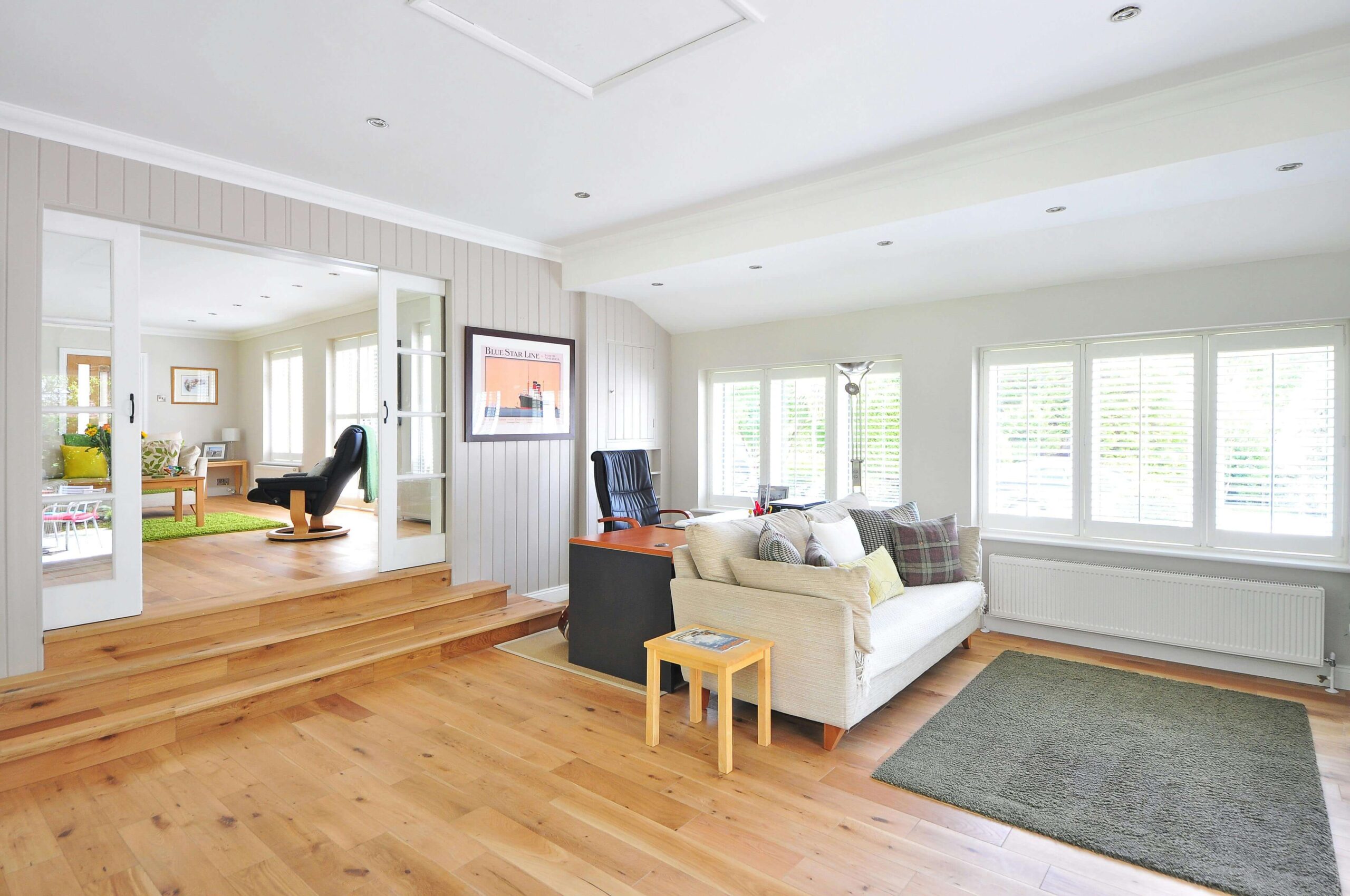
Step into any standout NYC home, and you'll notice it immediately—the floors make a statement. From sustainable bamboo that captures natural light to dramatic herringbone patterns that define luxury, your flooring choice sets the tone for everything above it. In...
Read More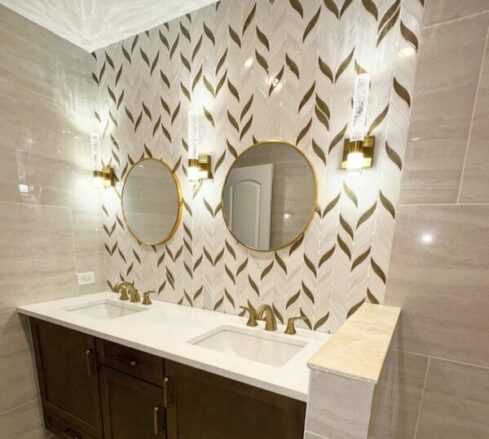
This blog post will provide practical, expert-backed ideas to help homeowners maximize space, style, and functionality in small bathrooms. The goal is to attract urban homeowners in NYC who are looking for space-saving solutions and professional renovation guidance while positioning...
Read More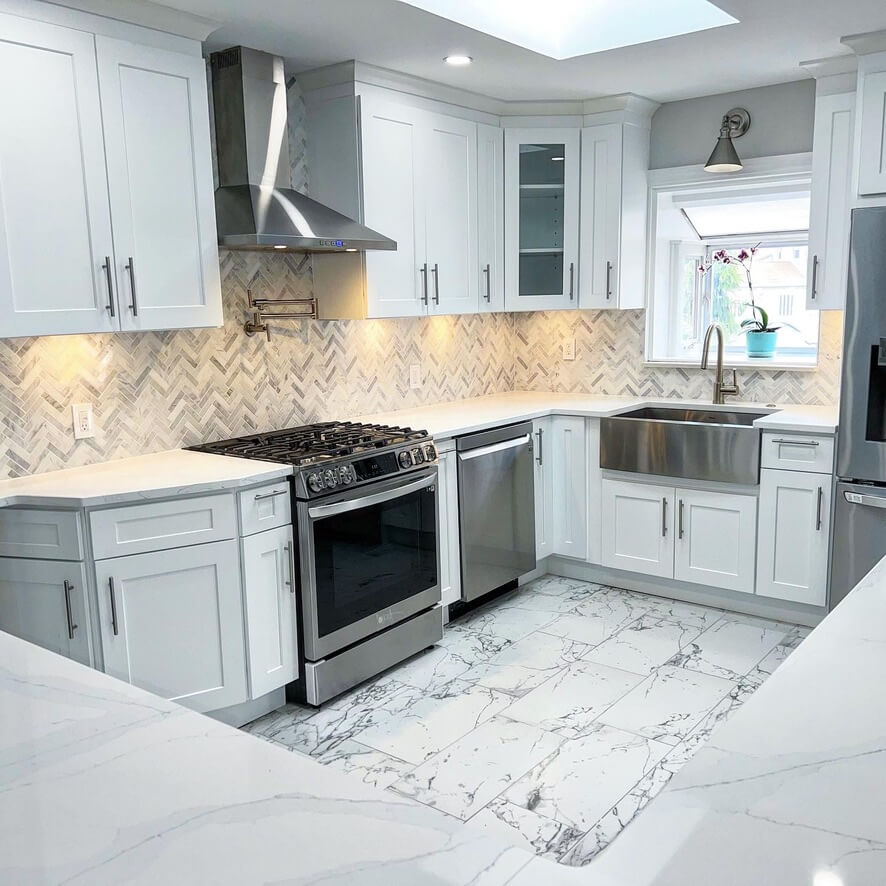
Imagine walking into your kitchen 10 years from now and still loving every detail—the elegant cabinetry, the classic finishes, and the perfect layout that makes cooking effortless. A timeless kitchen isn’t just about style; it’s about creating a space that...
Read More